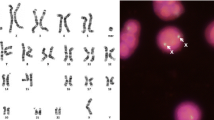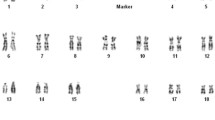Abstract
Small supernumerary marker chromosomes (SMCs) in human can be defined as additional centric chromosome fragments smaller than chromosome 20. For most small or minute SMCs a correlation with clinical symptoms is lacking, mostly due to problems in visualizing their euchromatic content. Recently we described two new molecular cytogenetic approaches for the comprehensive characterization of small SMCs, excluding those few cases with neo-centromeres. Minute SMCs, consisting preferentially of alpha-satellite DNA, are characterizable in one step by the centromere-specific multicolor FISH (cenM-FISH) approach. For further characterization of minute SMCs and eventually present euchromatic content, the recently developed centromere-near-specific multicolor FISH (subcenM-FISH) technique can be applied. These two approaches are highly informative and easy to perform, as demonstrated in the present report on the example of a prenatal case with a minute SMC derived from chromosome 3 cytogenetically described as min(3)(:p12.1→q11.2:).
Similar content being viewed by others
References
Anderlid BM, Sahlen S, Schoumans J et al. (2001) Detailed characterization of 12 supernumerary ring chromosomes using micro-FISH and search for uniparental disomy. Am J Med Genet 99: 223-233.
Barbi G, Spaich C, Adolph S, Kehrer-Sawatzki H (2003) Analphoid de novo marker chromosome inv dup(3)(q28qter) with neocentromere in a dysmorphic and developmentally retarded girl. J Med Genet 40: e27.
Betz A, Turleau C, de Grouchy J (1974) [Heterozygosity and homozygosity for a pericentric inversion of human chromosome 3]. Ann Genet 17: 79-80.
Callen DF, Eyre HJ, Ringenbergs ML, Freemantle CJ, Woodroffe P, Haan EA (1991) Chromosomal origin of small ring marker chromosomes in man: characterization by molecular genetics. Am J Hum Genet 48: 769-782.
Cockwell AE, Gibbons B, Moore IE, Crolla JA (2000) An analphoid supernumerary marker chromosome derived from chromosome 3 ascertained in a fetus with multiple malformations. J Med Genet 37: 807-810.
Crolla JA, Howard P, Mitchell C, Long FL, Dennis NR (1997) A molecular and FISH approach to determining karyotype and phenotype correlations in six patients with supernumerary marker(22) chromosomes. Am J Med Genet 72: 440-447.
Hills LV, Nouri S, Slater HR (2003) Pericentromeric euchromatin is conserved in minute human supernumerary chromosomes: a study using cross-species colour segmenting (RxFISH). Chromosome Res 11: 359-363.
Ilberry PLT, Lee CWG, Winn SM (1961) Incomplete trisomy in a mongoloid child exhibiting minimal stigmata. Med J Austr 48: 182-184.
James RS, Temple IK, Dennis NR, Crolla JA (1995) A search for uniparental disomy in carriers of supernumerary marker chromosomes. Eur J Hum Genet 3: 21-26.
Kotzot D (1999) Abnormal phenotypes in uniparental disomy (UPD): fundamental aspects and a critical review with bibliography of UPD other than 15. Am J Med Genet 82: 265-274.
Levy B, Jalal SM, Dunn TM et al. (2002) Unique case of mosaicism involving two morphologically similar marker chromosomes of different centric origin in a patient with developmental delay. Am J Med Genet 108: 198-204.
Liehr T, Heller A, Starke H et al. (2002) Microdissection based high resolution multicolor banding for all 24 human chromosomes. Int J Mol Med 9: 335-9.
Liehr T, Nietzel A, Starke H et al. (2003) Characterization of small marker chromosomes (SMC) by recently developed molecular cytogenetic approaches. J Ass Genet Techn 29: 5-10.
Müller-Navia J, Nebel A, Schleiermacher E (1995) Complete and precise characterization of marker chromosomes by application of microdissection in prenatal diagnosis. Hum Genet 96: 661-667.
Müller-Navia J, Nebel A, Oehler D, Theile U, Zabel B, Schleiermacher E (1996) Microdissection and DOP-PCR-based reverse chromosome painting as a fast and reliable strategy in the analysis of various structural chromosome abnormalities. Prenat Diagn 16: 915-922.
Nietzel A, Rocchi M, Starke H, et al. (2001) A new multicolor-FISH approach for the characterization of marker chromosomes: centromere-specific multicolor-FISH (cenMFISH). Hum Genet 108: 199-204.
Oliver-Bonet M, Liehr T, Nietzel A et al. (2003) Karyotyping of human synaptonemal complexes by cenM-FISH. Eur J Hum Genet 11: 879-883.
Paoloni-Giacobino A, Morris MA, Dahoun SP (1998) Prenatal supernumerary r(16) chromosome characterized by multiprobe FISH with normal pregnancy outcome. Prenat Diagn 18: 751-752.
Portnoi MF, Boutchnei S, Bouscarat F et al. (1999) Skin pigmentary anomalies and mosaicism for an acentric marker chromosome originating from 3q. J Med Genet 36: 246-250.
Rauch A, Pfeiffer RA, Trautmann U, Liehr T, Rott HD, Ulmer R (1992) Study of ten small supernumerary (marker) chromosomes identified by fluorescence in situ hybridization (FISH). Clin Genet 42: 84-90.
Rothemund H, Greenberg CR, Dawson AJ (1998) Mosaic supernumerary marker chromosome identified as a der(3) by FISH. Clin Genet 54: 526-527.
Starke H, Nietzel A, Weise A et al. (2003a) Small supernumerary marker chromosomes (SMCs): genotype-phenotype correlation and classification. Hum Genet 114: 51-67.
Starke H, Mitulla B, Nietzel A et al. (2003b) First case of trisomy 21 accompanied by an additional der(4)(:p11?q11:) plus partial uniparental disomy 4p15-16. Am J Med Genet 116A: 26-30.
Teshima I, Bawle EV, Weksberg R, Shuman C, Van Dyke DL, Schwartz S (2000) Analphoid 3qter markers. Am J Med Genet 94: 113-119.
Viersbach R, Engels H, Gamerdinger U, Hansmann M (1998) Delineation of supernumerary marker chromosomes in 38 patients. Am J Med Genet 76: 351-358.
von Eggeling F, Hoppe C, Bartz U et al. (2002) Maternal uniparental disomy 12 in a healthy girl with a 47,XX, +der(12)(:p11?q11:)/46,XX karyotype. J Med Gen 39: 519-521.
Wandall A, Tranebjaerg L, Tommerup N (1998) A neocentromere on human chromosome 3 without detectable alpha-satellite DNA forms morphologically normal kinetochores. Chromosoma 107: 359-65.
Warburton D (1991) De novo balanced chromosome rearrangements and extra marker chromosomes identified at prenatal diagnosis: clinical significance and distribution of breakpoints. Am J Hum Genet 49: 995-1013.
Author information
Authors and Affiliations
Rights and permissions
About this article
Cite this article
Liehr, T., Hickmann, G., Kozlowski, P. et al. Molecular–cytogenetic characterization of the origin and the presence of pericentromeric euchromatin on minute supernumerary marker chromosomes (SMCs). Chromosome Res 12, 239–244 (2004). https://doi.org/10.1023/B:CHRO.0000021916.18019.1c
Issue Date:
DOI: https://doi.org/10.1023/B:CHRO.0000021916.18019.1c




